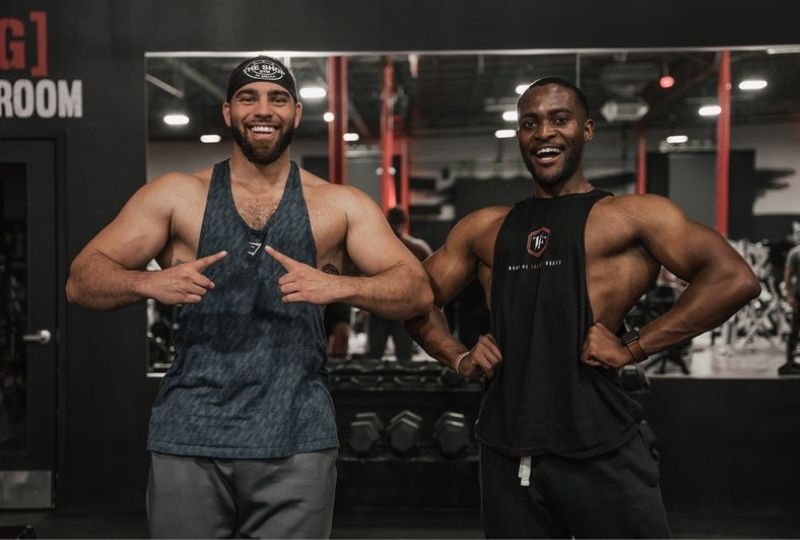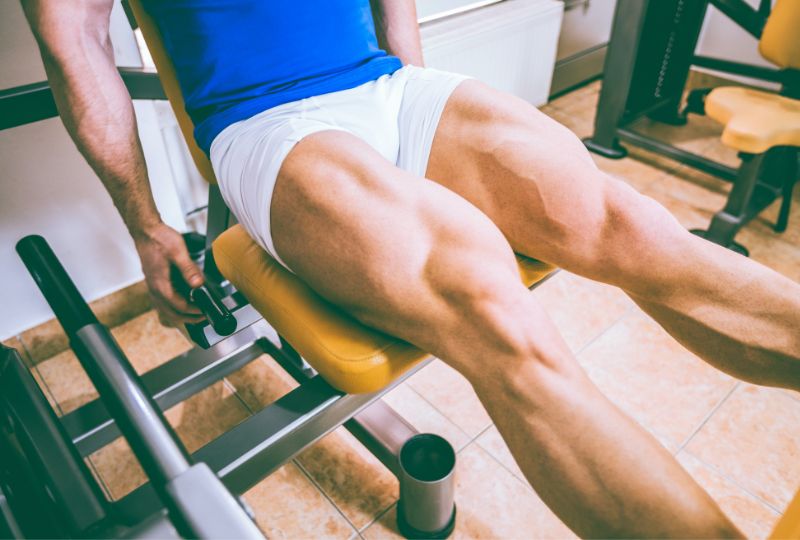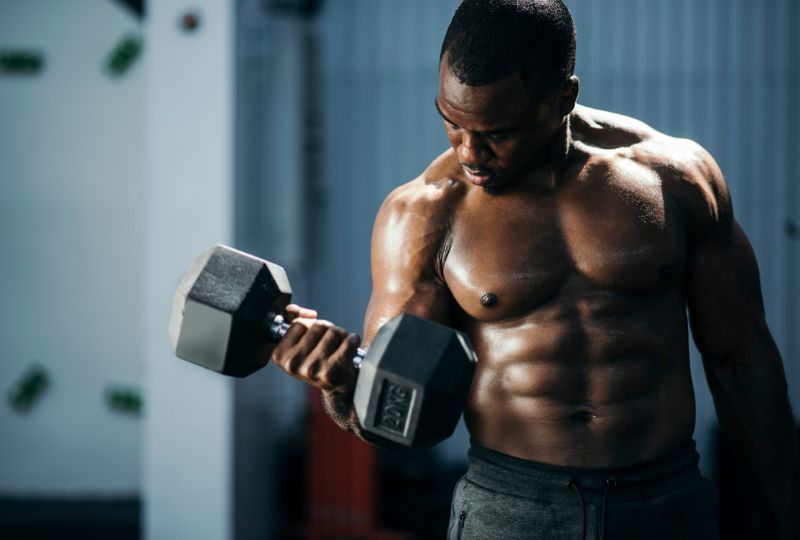What's inside
So, you’ve started lifting.
Maybe you’ve seen some good results in the first six months or more using a traditional full-body program.
But now it’s time to take your training to the next level. You need more focused workouts to give the different muscle groups continued stimulus to grow.
Split workouts are frequently used to give the major muscle groups a higher volume, allowing you to employ more exercises and sets for a given body part.
But which split program should you choose?
Two of the most popular splits are the ‘bro split’ and the push/pull/legs split.
This article will provide a comparison between the bro split vs PPL, with the pros, cons, and use cases for each.
There are also complete workout programs using each split for you to use for your own training.
Let’s dive in.
Overview of Split Training
Related: How Long Does It Take To Get Ripped

Split training refers to any resistance training program that breaks the major muscle groups into multiple workout sessions.
After beginning with a full-body workout two to three times per week, beginner lifters usually progress to one of several types of workout split.
The most commonly used split programs are upper/lower body, PPL, and the bro split.
To clarify here, a split program doesn’t refer to the number of days per week you train.
For example, an upper/lower body split can involve lifting two, four, or six days per week.
That being said, here are the most common schedules for each of the split mentioned above programs:
| Schedule | Upper Lower | Bro Split | Push Pull Legs |
| Monday | Upper body | Chest | Push |
| Tuesday | Lower body | Back | Pull |
| Wednesday | Rest day | Legs | Legs |
| Thursday | Upper body | Shoulders | Push |
| Friday | Lower body | Arms | Pull |
| Saturday | Rest day | Rest day | Legs |
| Sunday | Rest day | Rest day | Rest |
Here is another simplified way to break down split programs by training days:
Days Available to Train:
- 3 days per week: Full body program
- 4 days per week: Upper/lower body split
- 5 days per week: Bro split
- 6 days per week: Push/pull/legs split
This article will focus on the bro split vs. PPL, two intermediate to advanced programs.
Next, we’ll break down the pros and cons of these two popular training methodologies.
What is a bro split?
As it’s lovingly known in the fitness community, a bro split is a style of training that has been popular in bodybuilding circles for decades.
While there are several variations of the bro split, the general guidelines are a 5-day split, training a specific body part in each session.
The bro split is usually performed Monday to Friday, with the weekend left for resting, some extra cardio, or other active pastimes and sports.
Here is one example of a commonly seen bro split schedule:
Weekly Schedule:
- Monday: Chest workout
- Tuesday: Back workout
- Wednesday: Legs workout
- Thursday: Shoulder workout
- Friday: Arms workout
- Saturday: Rest day
- Sunday: Rest day
One study surveying 127 competitive bodybuilders found that 68% used a ‘bro split,’ training each muscle group only once per week.
What are the benefits of a bro split?
Related: Horizontal Push Exercises
One of the reasons the bro split is so popular is that it’s such a fun way to train.
Pumping massive amounts of blood into the chest or arms is always good, leaving the muscles looking and feeling huge.
Anecdotally, I also think this type of split is popular for having four sessions for the upper body and only one for the legs.
As much as everyone wants quads like Ronnie Coleman, it’s no secret that leg training is hard, mentally and physically.
Having just one leg day to get through and training the ‘fun’ stuff the other four days is a plus for many lifters.
The other main benefit of a bro split is that it leaves room for specialized isolation exercises, which can target down even to particular segments of a single muscle.
This is great for those wanting to bring up any weak points in their body. It’s particularly valuable for bodybuilders needing to sculpt each muscle in a particular way for competition.
Training each muscle group only once also ensures plenty of recovery time for the muscles, although possibly too much, as we’ll see.
Drawbacks of a Bro Split
Despite being a fun and popular training method, the bro split is not perfect.
The main drawback of the bro split is its lack of frequency, only training each muscle group once per week.
Research reviews of training frequency for muscle hypertrophy have suggested that the major muscle groups should be trained at least twice per week to maximize muscle growth.
There are other factors involved, however. Plus, the fact that so many advanced lifters continue to use the bro split speaks to its effectiveness in certain situations.
Another feature some may consider a drawback of the bro split is the high level of DOMS, or delayed onset muscle soreness, after a workout targeting a single muscle group.
While any novel exercise can create soreness depending on your training level, anyone who has done an intense bro split session can attest to the days of soreness afterward.
There’s a reason stairs are the stuff of nightmares for bodybuilders after a heavy leg session!
What is PPL or a Push Pull Legs Split?
Related: 4 Day Push Pull Workout Routine
Next, we have arguably the most popular weight training split.
Push/pull/legs, or PPL for short, is a 3-day split program dividing the muscle groups based on muscles that contribute to different compound movements.
A push workout trains shoulder flexion, shoulder abduction, and elbow extension muscles. Namely, the pecs, anterior and side delts, and the triceps.
A pull session targets muscle groups involved in shoulder extension and adduction and elbow flexion – including the lats, traps, biceps, and many other supporting back muscles.
A legs (some people use L to mean lower body) day incorporates the large muscle groups involved in hip, knee, and ankle motion.
The major muscle groups include the quads, hamstrings, glutes, and calves. A lower body day might also involve exercises for the core and lower back.
While a PPL split can be used once per week, most people follow a training schedule like this:
Weekly Schedule:
- Monday: Push workout
- Tuesday: Pull workout
- Wednesday: Legs workout
- Thursday: Push workout
- Friday: Pull workout
- Saturday: Legs workout
- Sunday: Rest day
Let’s look at the reasons for and against this widely-used training schedule.
What are the benefits of PPL?
Related: What Is The Best 6-Day Workout Split?
The biggest benefit of PPL is the additional frequency for each muscle group.
The combination of resistance training and protein ingestion increases muscle protein synthesis, allowing us to build muscle.
Research shows muscle protein synthesis more than doubles 24 hours post-training and returns to near baseline by 36 hours.
This means that the effect of a workout in increasing protein synthesis has essentially worn off two days after the session.
A split like PPL ensures this elevation happens more frequently, allowing the muscles to grow consistently when this is the case.
In the same way that many lifters like the bro split, a large group also like being able to hit certain muscles more than just once a week for the feel of it.
Drawbacks of PPL
Combining large muscle groups into movement patterns means that a PPL program usually involves mostly high-intensity sessions.
A PPL split focuses more on large compound lifts, with some accessory work where necessary.
These lifts require more neural recruitment, causing more central fatigue and higher cardiovascular demand.
Since you have to train three or more muscle groups in a single session, there is less time for isolation exercises, many of which people enjoy doing.
You’ll also have to commit to six full sessions a week unless you skip the second leg day on Saturday (which many lifters do – sometimes just out of exhaustion).
That being said, PPL is an excellent option for intermediate to advanced lifters when programmed optimally for the individual.
Bro Split vs. PPL: Which one is the better option?
Now that we’ve gone into more detail regarding both split programs, it’s time to explore which one is the better fit for you.
This section will narrow down the critical differences between each split program, and explore scenarios in which each would be optimal.
We’ll also take a look at which split several popular fitness figures are currently using.
What are the core differences between a bro split and PPL?
The following table breaks down the major differences between the bro split vs. PPL.
This table is an example in which both splits have been equated for overall volume.
Take a look at the highlighted points here:
| Feature | Bro Split | Push Pull Legs |
| Frequency | 1x per muscle group per week | 2x per muscle group per week |
| Weekly volume | 20 sets per muscle group | 20 sets per muscle group |
| Session volume | 20 sets per muscle group | 10 sets per muscle group |
| No. of exercises | 5 per muscle group | 2 per muscle group |
| Total training days | 5-6 per week | 6 per week |
As you can see, the main differences between the two programs are frequency, the number of sets per muscle group in one workout, and the variety of exercises for each muscle.
So, how do these differences affect the choice of which program is best for you?
What is the best option?
The bro split is best for advanced bodybuilders or lifters who want the flexibility to include a wider range of exercises that target every part of a muscle group.
If you want capped shoulders, a higher bicep peak, or a more defined quad sweep, the bro split will allow you to include exercises and volume on any area you like.
This is the better choice for those who have a good amount of muscle and now want to shape it as aesthetically as possible.
As for PPL, this may be better suited to intermediate trainees who are still focused on packing on size.
Hitting the major muscle groups with that higher frequency will accelerate the mechanisms of muscle hypertrophy overall.
The PPL will also allow a faster progression for those focused on increasing strength.
Training the large compound lifts twice a week, with some accessory work to bring up weak points, will ensure the greatest gains in your 1RM totals.
If you still can’t decide which split to pick, unless you’re planning on entering a competition in the near future, either split will provide you with great gains.
The workout programs below are designed to allow you to pick either one, making them as close as possible in terms of effectiveness.
Try out both programs for a few weeks, and continue with whichever one you prefer!
Of course, no split will be effective forever. As the body adapts, you can switch from one of these programs to the other to keep the gains coming.
Who uses Bro Split vs. PPL?
Related: Reverse Pyramid Training
This section is just a brief look at some of the bro split and PPL programs and advice from some prominent fitness figures.
The first is from Jeff Nippard, who outlines a great PPL split that focuses on different muscle groups within the split itself.
The next clip is some excellent advice from the late, great John Meadows, around a balance between bro splits and PPL, as well as how PEDs can affect which split to choose.
Another beast, Ryan Humiston, is a big fan of the bro split for its ability to create a strong mind-muscle connection each session.
What about the GOAT of bodybuilding, Arnold Schwarzenegger? Check out our article on the Arnold split, which is in another league altogether.
Now, it’s time to go through the actual workout programs of the bro split and PPL.
Push Pull Legs Workout Program
Related: 10 Best Outer Quad Exercises
This PPL workout consists of three workouts, targeting horizontal and vertical pressing, pulling, and lower body movements.
This program features predominantly compound exercises, with some accessory exercises to strengthen common weak points in the big lifts.
Push Workout

We start the split with the push workout. The focus is on the bench and overhead presses.
If you want to focus on your overhead lifting, you can switch the first two exercises and perform the prescribed repetition scheme for the shoulder press instead.
| Exercise | Sets x Reps | Rest |
| Bench press | 5×12/10/8/6/6 | 1-3 mins |
| Overhead press | 5×8-12 | 1-3 mins |
| Assisted / weighted chest dips | 5×8-12 | 1-3 mins |
| Lateral raise | 5×8-12 | 1 min |
| Tricep OH cable extension | 5×8-12 | 1 min |
Pull Workout
Next, we have the pull session, with the heavy T-bar row kicking off the workout.
A couple of modifications that can be made here include switching the bent-over barbell row for the T-bar if you prefer, and performing weighted pull-ups as the first exercise.
The pull workout in the PPL split also includes an exercise for the posterior deltoid as it is involved more in pulling movements than in pushing.
| Exercise | Sets x Reps | Rest |
| T-bar row | 5×12/10/8/6/6 | 1-3 mins |
| Pull-ups / Lat pulldown | 5×8-12 | 1-3 mins |
| Shrugs | 5×8-12 | 1-3 mins |
| dB lat pullovers | 5×8-12 | 1 min |
| Reverse flys | 5×8-12 | 1 min |
Legs Workout
Related: Why Are My Legs So Skinny

The third session is all about the legs, with fundamental movement patterns such as the squat, lunge, and hip hinge.
In addition to switching exercises, this workout can be modified to focus more on different parts of the leg musculature.
For example, the squat, leg press, and lunge can all be performed with different foot placements to emphasize the quads, hamstrings, or glutes.
Likewise, the Romanian deadlift (which targets the hamstrings) can be swapped out for a sumo deadlift (glutes) or narrow-stance trap bar deadlift (more quads).
| Exercise | Sets x Reps | Rest |
| Squat | 5×12/10/8/6/6 | 1-3 mins |
| Leg press | 5×8-12 | 1-3 mins |
| Split squat / Reverse lunge | 5×8-12 | 1-3 mins |
| Romanian deadlift | 5×8-12 | 1-3 mins |
| Standing / seated calf raise | 5×8-12 | 1 min |
As mentioned, the schedule of this program involves a six-day training week, with a rest day on Sunday.
Alternatively, you can perform this split in a four-day cycle, resting every fourth day after the leg workout.
While this will allow for slightly more recovery time if you’re getting overly tired, it will create an irregular weekly schedule.
Weekly Schedule:
- Monday: Push workout
- Tuesday: Pull workout
- Wednesday: Legs workout
- Thursday: Push workout
- Friday: Pull workout
- Saturday: Legs workout
- Sunday: Rest day
Bro Split Workout Program
Related: What Does PR Mean In The Gym? Track And Set New PRs
Next, we have the bro split program. This version is a relatively common style of the bro split, with an optional twist at the end.
Get ready to carve each and every muscle out just the way you want, leaving no muscle fiber untouched!
Chest Workout
Of course, a good bro split has to start with ‘international chest day’. While you may want to start your week by getting your legs out of the way, training your chest is more fun.
The heavy compound bench press is your main way to build overall strength in the chest, before targeting the clavicular and pectoral heads with angled pressing.
Next, you’ll target the inner and outer portions of the muscles, with a fly movement to create a great stretch and a crossover for maximal contraction.
| Exercise | Sets x Reps | Rest |
| Bench press | 4×12/10/8/6 | 1-3 mins |
| Incline dB press | 4×8-12 | 1 min |
| Assisted / weighted chest dips | 4×8-12 | 1-3 mins |
| dB chest fly | 4×8-12 | 1 min |
| Decline cable crossover | 4×12-15 | 1 min |
Back Workout

After building a huge chest on Monday, we balance it out with a good back session on Tuesday.
Starting with deadlifts to fire up the lats and spinal erectors (and to avoid having to do them on leg day), we work our way around the areas of the back.
Experiment with different grips for the pulldown and row, creating a better connection with the lats, mid traps, and rhomboids.
While the cable straight-arm pushdown is a great way to isolate and contract the lats, you could also do a dumbbell pullover if you want to feel more of a stretch.
| Exercise | Sets x Reps | Rest |
| Deadlift | 4×12/10/8/6 | 1-3 mins |
| Lat pulldown | 4×8-12 | 1 min |
| Supported row | 4×8-12 | 1 min |
| One-arm wide row | 4×8-12 | 1 min |
| Cable straight-arm pushdown | 4×12-15 | 1 min |
Leg Workout
Related: Leg Press Foot Placement
On Wednesday, we give the upper body a breather and tackle the hardest workout of the week.
The heavy work will be done with the squat and hip thrust. You can perform variations like the high bar, low bar, sumo, or front squats.
Next, we isolate the quads and hamstrings with some single-joint movements and finish off with an often neglected muscle group, the hip adductors.
You can also perform your calf exercises in this workout, or save them for the bonus sixth workout.
| Exercise | Sets x Reps | Rest |
| Squats | 4×12/10/8/6 | 1-3 mins |
| Barbell hip thrust | 4×8-12 | 1 min |
| Leg extension | 4×8-12 | 1 min |
| Hamstring curl | 4×8-12 | 1 min |
| Adductor machine | 4×8-12 | 1 min |
Shoulder Workout
As you hobble into the gym after leg day, the week’s not over yet.
The shoulder session starts with some heavy pressing, which can be done seated or standing.
While standing will allow you to lift more weight, care must be taken to maintain a strong and stable spine to avoid injury.
In the bro split, the traps are sometimes added to the shoulder session, as they work with the deltoids in many shoulder elevation movements.
Note that many people have weak and underdeveloped posterior delts, so feel free to move the reverse pec deck up in the exercise order if you feel yours are lagging.
| Exercise | Sets x Reps | Rest |
| Overhead press | 4×12/10/8/6 | 1-3 mins |
| Trap shrugs | 4×8-12 | 1 min |
| Lateral raise | 4×8-12 | 1 min |
| Reverse pec deck | 4×8-12 | 1 min |
| Face pulls | 4×12-15 | 1 min |
Arms Workout

For Friday, you know we have to get the gun show going with a sleeve-splitting arm workout.
The exercises in this session alternate between biceps and triceps to allow these smaller muscle groups to recover between exercises.
Focus on increasing the weight (safely) with the barbell curl, using the other exercises to create metabolic overload.
The triceps will get plenty of heavy loading with the bench and overhead presses, so again focus on fatiguing them through volume.
The reverse preachers are to develop the brachioradialis of the forearms. If you want more tips on how to build your forearms and grip strength, check out our guide on grip exercises.
| Exercise | Sets x Reps | Rest |
| Barbell curls | 4×12/10/8/6 | 1-3 mins |
| Tricep cable pushdown | 4×8-12 | 1 min |
| Supinating curls | 4×8-12 | 1 min |
| Lying bar extension + Close grip press | 4×8-12 + failure | 1 min |
| Reverse preacher curls | 4×12-15 | 1 min |
Calves + Abs Workout
Related: Weighted Ab Workouts
Finally, we have an optional Saturday workout. This one focuses on calves and abs but can include any other lagging muscles that you want to give more love to.
If you prefer a well-earned rest on Saturday, you can simply add your calf exercises to the leg day and train abs at the end of every second session.
| Exercise | Sets x Reps | Rest |
| Standing calf raise | 5×12-15 | 1 min |
| Seated calf raise | 5×8-12 | 1 min |
| Weighted decline crunch | 5×15-20 | 1 min |
| Hanging knee raise | 5xMAX | 1 min |
The bro split can be a good program for creating a habit with your regular training week.
As we’ve said, most bro splits span Monday to Friday, with the weekend free for rest, recovery, and fun.
Modify the program above to suit your schedule, as that’s the best way to ensure you’ll stick to it!
Weekly Schedule:
- Monday: Chest workout
- Tuesday: Back workout
- Wednesday: Legs workout
- Thursday: Shoulder workout
- Friday: Arms workout
- Saturday: Calves + Abs workout (optional)/Rest day
- Sunday: Rest day
There you have it! Try these programs and you’ll be getting guaranteed gains in no time.
One final note on the programming – while the overall volume was matched with both programs, 20 sets per week per muscle group is on the high end.
To modify this for a newer intermediate level, simply perform three or four sets of each exercise instead of five.
You can always work your way up from there, and it’s better to leave yourself space to progress in your program.
Frequently Asked Questions
Why do bodybuilders use the bro split?
High-level bodybuilders often need a full session to program five or more exercises and hit a muscle from every angle.
That being said, the bro split can be flexible and won’t always look like the example above.
Is PPL better than upper lower split?
While both can be effective depending on the individual, the PPL split has one big advantage over upper/lower splits – in my opinion.
Having only one upper body workout to fit in the chest, back, shoulders, and arms can lead to neglecting certain areas.
A PPL split breaks up the upper body again, leaving you more room to include specific exercises and train harder.
Should beginners do PPL split?
Beginners in the gym are best suited to full-body training, two to three times per week.
While the PPL split is a great program, jumping into it too soon could lead to overtraining and injury.
PPL can definitely be considered the next step when moving on from a beginner program.
Is bro split better for hypertrophy?
This article has covered the pros and cons of both split programs, particularly when it comes to growing muscle.
Both the bro split and PPL split can be used to create muscle hypertrophy, just in slightly different ways.
If you want to build overall mass, the PPL might be the best choice. For growth in specific sections of each muscle, consider the bro split.
Is bro split good for fat loss?
When it comes to losing body fat, the type of training split you do is only important in regard to preserving muscle mass.
Creating a calorie deficit through diet and aerobic exercise should be the main focus when cutting.
Many bodybuilders continue the same split in contest preparation, adding cardio and performing slightly higher reps in their weight training.
Later, bro!
So, what do you think about the bro split vs. PPL? It’s interesting to compare two of the most frequently used workout splits in today’s fitness scene.
Are you a fan of the bro split, or do you prefer a three-day split like push/pull/legs?
Let us know which workout split you think wins between a bro split and PPL in the comments!
If you have friends or family who can’t decide which training plan to choose, don’t forget to send this article their way.

